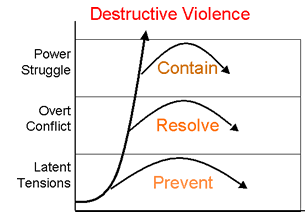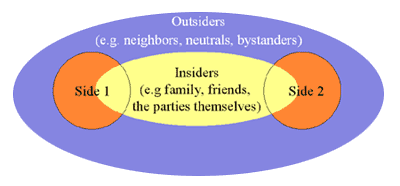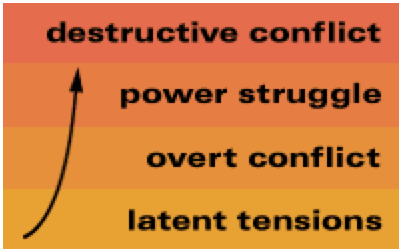The 10 Roles Applied
Stories are powerful tools to bring to life the experience of the Third Side. Stories can transform one’s understanding and even at times provide guidance and inspiration to those in conflict. These stories are a few of the many 3S stories that are being shared around the world. The stories here are grouped into general stories, and stories emphasizing each of the nine thirdside roles.
The Bridge Builder: Fish Hooks and Trust
It is not easy to build bridging relationships, particularly in conditions of actual conflict. That did not deter Sidney Frankel, a Johannesburg businessman who, in August 1991, invited Cyril Ramaphosa, a prominent young black leader in the African National Congress, and Roelf Meyer, a young white leader in the ruling Nationalist Party government, to his country cottage for the weekend. As Meyer and his family arrived by helicopter, they discovered that Frankel's ten-year-old daughter had fallen and broken her arm; so Frankel, his wife, and daughter took the helicopter to ...
The Bridge Builder: Sisterhood Under Fire
By Carole Frampton
Ida lives in Bujumbura, the capital of Burundi. She is the president of a women's neighborhood association on the outskirts of the city. Until a series of intercommunal massacres in 1993, the association included and supported women from both the Hutu and Tutsi ethnic groups. The women owned some communal land and shared its harvest among themselves. When it became dangerous to live in mixed neighborhoods, the Hutu women fled the Musaga district to settle on the other side of the road, in Busoro. For six years, the association was split. Half the ...
The Teacher: Respect in Lucknow
In 1992, thousands of people died in Hindu-Muslim riots triggered by the destruction of a mosque at Ayodhya by a group of Hindu militants, yet in the state capital of Lucknow, only forty miles away from Ayodhya, there was not one casualty. The reason? In part, it was the influence on the local culture of the largest private school in the world, the City Montessori School. Founded in 1959, the school has over twenty thousand students from kindergarten through twelfth grade. Influenced by the teachings of Mahatma Gandhi, it seeks to embue its Hindu, Sikh, and Muslim students ...
The Teacher: Heavy’s Transformation
"I don't know how smart Heavy was," says Michael Lewis, who taught him conflict resolution in a course given in a maximum-security prison. "He was just a moose of a guy who apparently had a very quick temper, and who in his earlier days had been very quick with his fists.
Sometime after Heavy got the training, a fellow prisoner told us, 'I can't believe it. Yesterday Heavy got into an argument and I thought he was going to drop the sucker right in his tracks. Heavy just kept talking to him!' The fellow prisoner was attributing it to the fact that Heavy had learned that ...
The Teacher: Fishing in Sierra Leone
By Phil Bob Hellmich
A trail of dust settled ahead of our rickety Toyota taxi as we chased a pickup truck along a dirt road through the bush of central Sierra Leone. The elephant grass gave way to rice paddies, and we drove slowly through a village as the taxi driver navigated between the chickens. I waved to a mother feeding her baby by one of the huts. She waved back with an enthusiastic smile that helped to assuage my apprehension about what we might find in Masongbo. We were on an assessment trip for Search for Common Ground, hoping to set up a reconciliation ...
The Teacher: Teaching Through Actions… Walking in Peace
February 08, 2004
By Barry Davis
The Middle Way – Mahatma Gandhi and Martin Luther King would, no doubt, have approved.
While politicians on both sides of the seemingly interminable bloody Middle East conflict remained entrenched, a small but growing group of Israeli Jews and Arabs have decided to take matters into their own hands. Actually, "into their own feet" would be a more accurate description of their peaceful protest.
Over the past couple of years hundreds of Jewish and Arab Israelis have taken part in silent peace walks in various regions of the ...
The Provider: Prevention Efforts Lead to a Revitalization
Why Once-Violent Neighborhoods Stayed Calm During the Blackout
August 24, 2003
By BRENT STAPLES
New Yorkers who lived through the arson and looting that ravaged the city during the blackout of 1977 were understandably edgy when the lights went out on Aug. 14. But it was clear by late evening that the blackout of 2003 would be nothing like its predecessor. This night did not belong to arsonists or looters; it belonged to families and neighbors who poured into the streets to use the headlights of parked cars for block parties and barbecues.
Why were things so quiet? ...
The Provider: Helping People Lift Themselves Up
Muhammad Yunus may not think of himself as engaged in conflict prevention, but he is a champion Provider. In 1976, as a young economics professor in the famine-stricken nation of Bangladesh, he met a village woman making a bamboo chair. He asked her how much profit she earned and was astonished to learn that it was only two pennies a day. "Why?" he asked. She explained that she had no bamboo of her own and had to buy it from a trader, who required in return that she sell him the finished chair at the low price he set. Yunus asked how much she needed to be able to buy her ...
The Provider: Meeting Needs to Save a Child
Boston, MA
"I've got to check in on America's worst nightmare,' announced the Reverend Eugene Rivers. "Ten-year-old kid. His daddy was shot through the head. His mama's got 'chemical' issues. He's a ringleader. You can just see it. He's been getting into trouble - they already caught him with a knife. He'll be packing a Glock [a gun] before long, unless someone gets to him."
"Hey, money," Rivers told the boy in a meeting arranged in the school library. "You know what I'm doing here? I'm gonna keep you outta jail." The boy stared at him without expression. "What do ...




